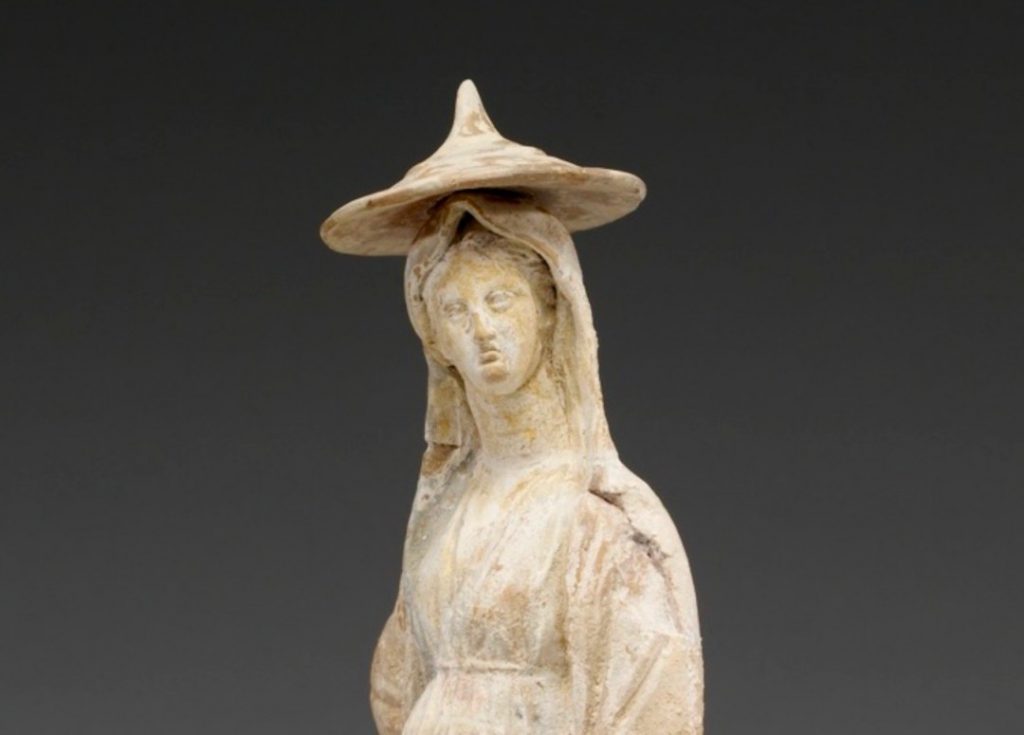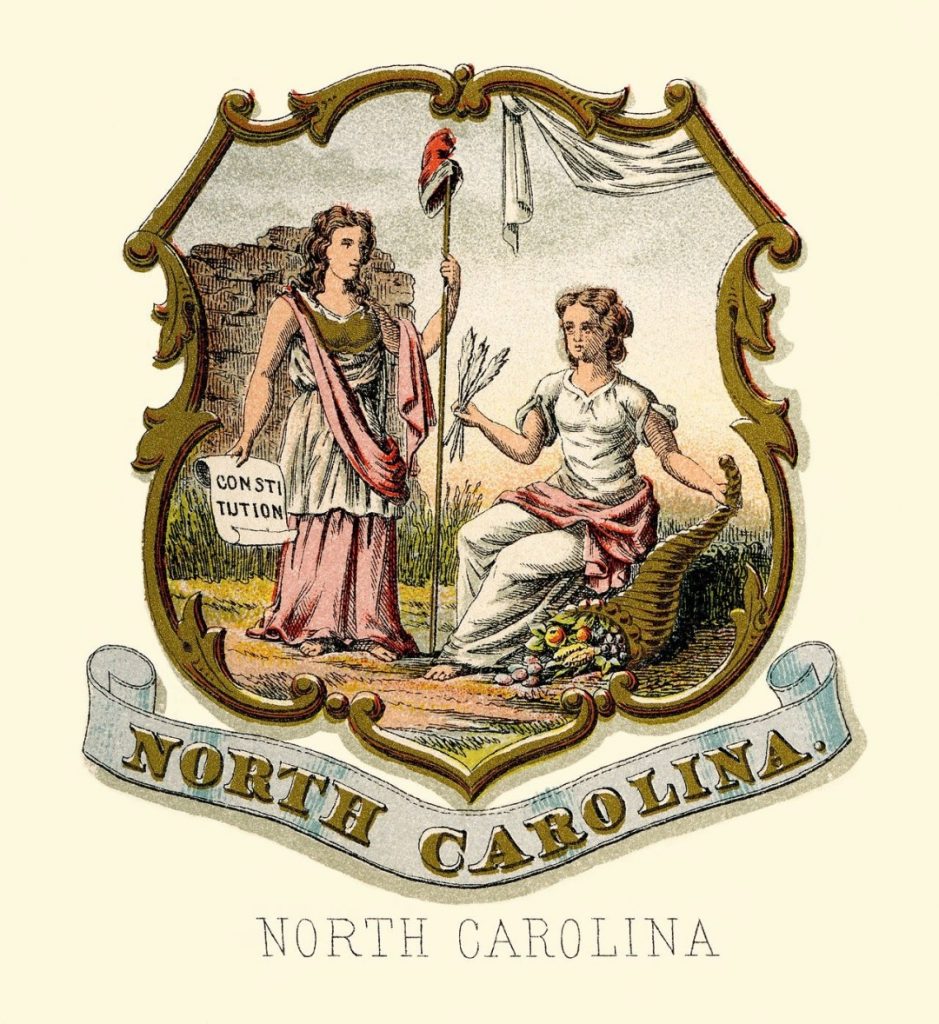BY: Sarah E. Bond
Originally published in: Hyperallergic.com
Despite the current political landscape of the US, we can look to antiquity to see that the red cap was actually once a symbol of citizenship and welcome to the foreigner.

In the ancient world, headgear was a primary way of identifying with a glance, the status, trade, gender, ethnic background, and religion of an individual. One could often spot a craftsman in their conical felt hat (in Greek, a πῖλος, in Latin a pileus or pilleus) or recognize a farmer from their wide-brimmed caps used to keep the sun off while bringing in the harvest.
While elite Roman men were often seen without hats, women and those of certain social statuses frequently had their heads covered while in public. In the fourth century BCE, a round straw hat with a raised center called a tholia came into vogue among Greek women. Moreover, a Roman woman in mourning used a head scarf called a ricinium that was likely dark in color. During mourning, this scarf replaced the traditional female head covering called a palla and told people who encountered her that she was a widow.

Hats were also a way of identifying foreigners in both life and art. The pileus was a hat popular within the area of Phrygia, an Anatolian kingdom which is now part of modern-day Turkey. It was made of either wool or felt and the top slumped forward. This Phrygian cap, as we call it today, was a way of identifying easterners like Amazons, Dacians (of modern Romania and Serbia), or Phrygians. Ancient artists often depicted mythological figures said to be from the eastern Mediterranean in this headware, men like the Trojan Aeneas, Ganymede, or Perseus.

The cap was also part of the iconographic clothing worn by the god Mithras, an eastern deity born from a rock who would later become popular in the Roman Mediterranean during the second and third centuries CE. Mithras was an Indo-Iranian god at the center of a mystery cult — meaning that initiates kept many of the rites and beliefs secret. He was fashioned as a sun-god and bull killer within his Roman context.
And temples, constructed to honor him, called mithraea, were a reflection of the cosmos itself. Often Mithras was depicted in the center, slaying a bull. Frescoes and reliefs of Mithras preserve the stunning color that decorated these underground mithraea. Their existence under the earth often helped to preserve the color so they may be viewed today. By some counts, 400 archaeological sites show evidence for the worshipping of the god and his cosmos.
At first, the Mithraic cults were popular among slaves, freedmen (i.e. slaves that had been manumitted), and Roman soldiers. Women were excluded from participation. Over time, the cult caught on and began to be acknowledged by the upper ranks of the social orders — all the way to equestrians, senators, and the emperor himself. Its early popularity with the hoi polloi has many parallels with the beginnings of Christianity, particularly that the birthday of Mithras was dated to December 25.
Early Christians don’t appear to have had as much affinity for the Phrygian cap as the followers of Mithras did—at least at first. However, Christian art did continue to use the Phrygian cap as a way of indicating the eastern identity of certain figures. Frescoes of the Magi bringing their gifts to the newly born Christ are often depicted wearing Phrygian caps — as they are in some of the earliest depictions from the catacombs in Rome. The Persian background of these men is further depicted in a sixth century CE mosaic in the Basilica of St. Apollinaris in Ravenna, Italy, which depicts the magi in traditional, patterned tights, tunics, and red Phrygian hats.
The use of red hats to distinguish identity was not new in Roman society. The Phrygian cap was similar to the red freedman’s cap that was worn by male slaves being manumitted by their masters. During manumission ceremonies, the change in hat denoted their change in status from a servile piece of property to a freed Roman citizen endowed with libertas.

At various times, the hat was used as a collective symbol of freedom beyond just manumission of individuals. Not long after the murder of Julius Caesar on the Ides of March in 44 BCE, one of the assassins, Brutus, minted coins with a freedom cap between two daggers as a sign of freedom from the tyranny of the dictator.
Crowds could rejoice in their freedom from an oppressive emperor by donning the freedman’s cap. This is the story we are told by the imperial historian Suetonius, who notes that upon the death of the emperor Nero in June of 68 CE: “such was the public rejoicing that the people put on liberty-caps and ran about all over the city.”
This was the birth of the red hat in the Mediterranean, at least, as a symbol of both resistance and freedom from oppression.

Although the Phrygian cap was most popular in the Roman period, it appears to have possibly influenced medieval headwear as well. Pope Constantine (r. 708-715) appears to have worn a type of frigium (the Greek letter phi, from Phrygian was often transliterated into Latin as either as a “ph” or an “f”) in order to enter into the city of Constantinople. The Phrygian cap and another type of headwear, known as the camelaucum (originally a camel skin cap), appear to have been combined and then modified for use by clerics in the early middle ages. It eventually informed the formation of the papal mitre by the 11th century, though it became white rather than red. The mitre would only grow in height over the years, but was originally a rather modest cap.
It was not until the eighteenth century that the red cap would have its renaissance as a symbol of revolution. In 1765, in the lead-up to the American Revolution, the liberty cap again made an appearance, this time within the context of the fight against the British. These red hats would be placed on pikes and paraded as symbols of resistance against colonial rule over the American colonies.

Not long thereafter, in the context of the French Revolution, the freedman’s cap would become the bonnet phrygien or bonnet rouge. It came into vogue in 1789 and 1790 as a symbol of liberty during the French Revolution. The sans-culottes (“those without knee breeches”) regularly donned the cap. It was rumored that Louis XVI was even forced to wear it following the overthrow of the French absolutist monarchy. Freedom from monarchy was the objective of a number of popular coups within the 18th century, but it is notable that other freedom movements also donned the cap. Abolitionists hoping to free slaves in French territories used the red cap in order to mark the push for the abolition of slavery in the French territories. A number of prints were created at the time with black men wearing liberty caps.
Taking a look around, it is clear that the alternate symbolism of orientalism and freedom encapsulated by ancient Phrygian headwear and then the red freedom cap has not completely disappeared from society. It is said that Belgian cartoonist Pierre Culliford (known as Peyo) had it in mind when creating Papa Smurf in the 1950s. And just a few years ago, sculptor Martin Puryear’s debut exhibition at Matthew Marks in the winter of 2014, attempted to remix and rethink the cap completely.

Even if in today’s political landscape in the US the red MAGA hats that dotted the landscape in the 2016 election have come to symbolize isolationism and exclusion of immigrant, we need only to look to antiquity to realize that the red cap was actually once a symbol of freedom and citizenship. Within the context of Mithras, it was also about recognizing and embracing the customs, habits, and religion of foreign-born persons, rather than using walls, executive orders, and hateful rhetoric to exclude them.



